Automatic Identification and Intelligent Optimization of Tunnel-Free Curve Reconfiguration
Abstract
1. Introduction
2. Method
2.1. Motivation
2.2. B-Spline Curve
2.3. KD-Tree
2.3.1. Create KD-Tree
2.3.2. Nearest Neighbor Query
2.4. Euclidean Clustering
2.4.1. Clustering Flow
2.4.2. Evaluation Indicator
3. Data Analysis
3.1. Data Acquisition
3.2. B-Spline Parameter Selection
3.3. Clustering Parameters Selection
4. Results
4.1. Fitting and Denoising Results
4.2. Indicator Results
4.3. Optimization Results
5. Conclusions
- (i)
- An automated algorithm based on B-spline curve and Euclidean clustering was constructed to identify, denoise, and optimize the tunnel point cloud model.
- (ii)
- KD-Tree accelerates the clustering of tunnel point clouds and improves the denoising efficiency.
- (iii)
- The influence of the Euclidean distance threshold on point cloud denoising was evaluated comprehensively using four indexes: precision, recall, F1-score, and RI, and the optimal Euclidean distance threshold for tunnel residual point clouds was determined.
- (iv)
- The effects of common and uncommon disturbances on the B-spline curve trend were observed by analyzing the curve-fitted profiles.
- (v)
- A comparison of algorithmic denoising results with manual denoising results from both qualitative and quantitative dimensions through analysis of the denoised profiles.
- (vi)
- A comparison of the results of the two B-spline fits, demonstrating that the optimized tunneling curve is highly accurate and robust.
Author Contributions
Funding
Institutional Review Board Statement
Informed Consent Statement
Data Availability Statement
Conflicts of Interest
References
- Wroblewski, A.; Wodecki, J.; Trybala, P.; Zimroz, R. A Method for Large Underground Structures Geometry Evaluation Based on Multivariate Parameterization and Multidimensional Analysis of Point Cloud Data. Energies 2022, 15, 6302. [Google Scholar] [CrossRef]
- Yasuda, N.; Cui, Y. Deformation estimation of a circular tunnel from a point cloud using elliptic Fourier analysis. Tunn. Undergr. Space Technol. 2022, 125, 104523. [Google Scholar] [CrossRef]
- Sun, W.X.; Wang, J.; Jin, F.X.; Li, Y.Y.; Yang, Y.K. An adaptive cross-section extraction algorithm for deformation analysis. Tunn. Undergr. Space Technol. 2022, 121, 104332. [Google Scholar] [CrossRef]
- Farahani, B.V.; Barros, F.; Sousa, P.J.; Cacciari, P.P.; Tavares, P.J.; Futai, M.M.; Moreira, P. A coupled 3D laser scanning and digital image correlation system for geometry acquisition and deformation monitoring of a railway tunnel. Tunn. Undergr. Space Technol. 2019, 91, 102995. [Google Scholar] [CrossRef]
- Xu, X.Y.; Yang, H.; Neumann, I. A feature extraction method for deformation analysis of large-scale composite structures based on TLS measurement. Compos. Struct. 2018, 184, 591–596. [Google Scholar] [CrossRef]
- Cao, Z.; Chen, D.; Peethambaran, J.J.; Zhang, Z.X.; Xia, S.B.; Zhang, L.Q. Tunnel Reconstruction With Block Level Precision by Combining Data-Driven Segmentation and Model-Driven Assembly. IEEE Trans. Geosci. Remote Sens. 2021, 59, 8853–8872. [Google Scholar] [CrossRef]
- Duan, D.Y.; Qiu, W.G.; Cheng, Y.J.; Zheng, Y.C.; Lu, F. Reconstruction of shield tunnel lining using point cloud. Autom. Constr. 2021, 130, 103860. [Google Scholar] [CrossRef]
- Yi, C.; Lu, D.N.; Xie, Q.; Liu, S.Y.; Li, H.; Wei, M.Q.; Wang, J. Hierarchical tunnel modeling from 3D raw LiDAR point cloud. Comput.-Aided Des. 2019, 114, 143–154. [Google Scholar] [CrossRef]
- Cheng, Y.J.; Qiu, W.G.; Duan, D.Y. Automatic creation of as-is building information model from single-track railway tunnel point clouds. Autom. Constr. 2019, 106, 102911. [Google Scholar] [CrossRef]
- Liu, M.H.; Sun, X.B.; Wang, Y.; Shao, Y.; You, Y.C. Deformation Measurement of Highway Bridge Head Based on Mobile TLS Data. IEEE Access 2020, 8, 85605–85615. [Google Scholar] [CrossRef]
- Wang, W.X.; Chen, W.W.; Kevin, W.; Shuang, L. Extraction of tunnel center line and cross-sections on fractional calculus, 3D invariant moments and best-fit ellipse. Opt. Laser Technol. 2020, 128, 106220. [Google Scholar] [CrossRef]
- Song, Z.F.; Yang, F.; Schonfeld, P.; Li, J.; Pu, H. Heuristic Strategies of Modified Levenberg-Marquardt Algorithm for Fitting Transition Curves. J. Surv. Eng. 2020, 146, 04020001. [Google Scholar] [CrossRef]
- Lopez-Rubio, E.; Thurnhofer-Hemsi, K.; Blazquez-Parra, E.B.; de Cozar-Macias, S.D.; Ladron-de-Guevara-Munoz, M.C. A fast robust geometric fitting method for parabolic curves. Pattern Recognit. 2018, 84, 301–316. [Google Scholar] [CrossRef]
- Sa, J.M.; Gu, H.W.; An, Y.L.; Luo, Y.J.; Zhang, Z.S.Y. Study on Curved Surface Fitting of Countersink Based on Point Cloud. IEEE Access 2020, 8, 106464–106470. [Google Scholar] [CrossRef]
- Li, X.J.; Chen, Z.Y.; Chen, J.Q.; Zhu, H.H. Automatic characterization of rock mass discontinuities using 3D point clouds. Eng. Geol. 2019, 259, 105131. [Google Scholar] [CrossRef]
- Xu, X.Y.; Kargoll, B.; Bureick, J.; Yang, H.; Alkhatib, H.; Neumann, I. TLS-based profile model analysis of major composite structures with robust B-spline method. Compos. Struct. 2018, 184, 814–820. [Google Scholar] [CrossRef]
- Zhao, X.; Kargoll, B.; Omidalizarandi, M.; Xu, X.Y.; Alkhatib, H. Model Selection for Parametric Surfaces Approximating 3D Point Clouds for Deformation Analysis. Remote Sens. 2018, 10, 634. [Google Scholar] [CrossRef]
- Yang, H.; Xu, X.Y.; Kargoll, B.; Neumann, I. An automatic and intelligent optimal surface modeling method for composite tunnel structures. Compos. Struct. 2019, 208, 702–710. [Google Scholar] [CrossRef]
- Yang, H.; Xu, X.Y. Multi-sensor technology for B-spline modelling and deformation analysis of composite structures. Compos. Struct. 2019, 224, 111000. [Google Scholar] [CrossRef]
- Xu, X.Y.; Yang, H. Robust model reconstruction for intelligent health monitoring of tunnel structures. Int. J. Adv. Robot. Syst. 2020, 17, 1729881420910836. [Google Scholar] [CrossRef]
- Xu, W.; Xu, X.Y.; Yang, H.; Neumanna, I. Optimized finite element analysis model based on terrestrial laser scanning data. Compos. Struct. 2019, 207, 62–71. [Google Scholar] [CrossRef]
- Lee, H.; Jung, J. Clustering-Based Plane Segmentation Neural Network for Urban Scene Modeling. Sensors 2021, 21, 8382. [Google Scholar] [CrossRef] [PubMed]
- Liu, H.Y.; Song, R.; Zhang, X.B.; Liu, H. Point cloud segmentation based on Euclidean clustering and multi-plane extraction in rugged field. Meas. Sci. Technol. 2021, 32, 095106. [Google Scholar] [CrossRef]
- Xu, X.B.; Zhang, L.; Yang, J.; Cao, C.F.; Tan, Z.Y.; Luo, M.Z. Object Detection Based on Fusion of Sparse Point Cloud and Image Information. IEEE Trans. Instrum. Meas. 2021, 70, 2512412. [Google Scholar] [CrossRef]
- Wang, D.; Wang, J.; Scaioni, M.; Si, Q. Coarse-to-Fine Classification of Road Infrastructure Elements from Mobile Point Clouds Using Symmetric Ensemble Point Network and Euclidean Cluster Extraction. Sensors 2020, 20, 225. [Google Scholar] [CrossRef]
- Wen, L.; He, L.; Gao, Z.H. Research on 3D Point Cloud De-Distortion Algorithm and Its Application on Euclidean Clustering. IEEE Access 2019, 7, 86041–86053. [Google Scholar] [CrossRef]
- Piegl, L.; Tiller, W. The NURBS Book; Springer: Berlin/Heidelberg, Germany, 1997. [Google Scholar]
- Farin, G. Curves and Surfaces for CAGD: A Practical Guide; Morgan Kaufmann: Burlington, MA, USA, 2002. [Google Scholar]
- Bureick, J.N.H.; Harmening, C.; Neumann, I. Curve and Surface Approximation of 3D Point clouds. Allg. Vermess.-Nachrichten. 2016, 123, 135–227. [Google Scholar]
- Liu, W.P.; Sun, J.; Li, W.Y.; Hu, T.; Wang, P. Deep Learning on Point Clouds and Its Application: A Survey. Sensors 2019, 19, 4188. [Google Scholar] [CrossRef]
- Cheng, D.Y.; Zhao, D.J.; Zhang, J.C.; Wei, C.S.; Tian, D. PCA-Based Denoising Algorithm for Outdoor Lidar Point Cloud Data. Sensors 2021, 21, 3703. [Google Scholar] [CrossRef]
- Lee, J.M. Fast k-Nearest Neighbor Searching in Static Objects. Wirel. Pers. Commun. 2017, 93, 147–160. [Google Scholar] [CrossRef]
- Xu, X.Y.; Wang, Z.H.; Shi, P.X.; Liu, W.; Tang, Q.; Bao, X.H.; Chen, X.S.; Yang, H. Intelligent monitoring and residual analysis of tunnel point cloud data based on free-form approximation. Mech. Adv. Mater. Struct. 2022, 1–10. [Google Scholar] [CrossRef]
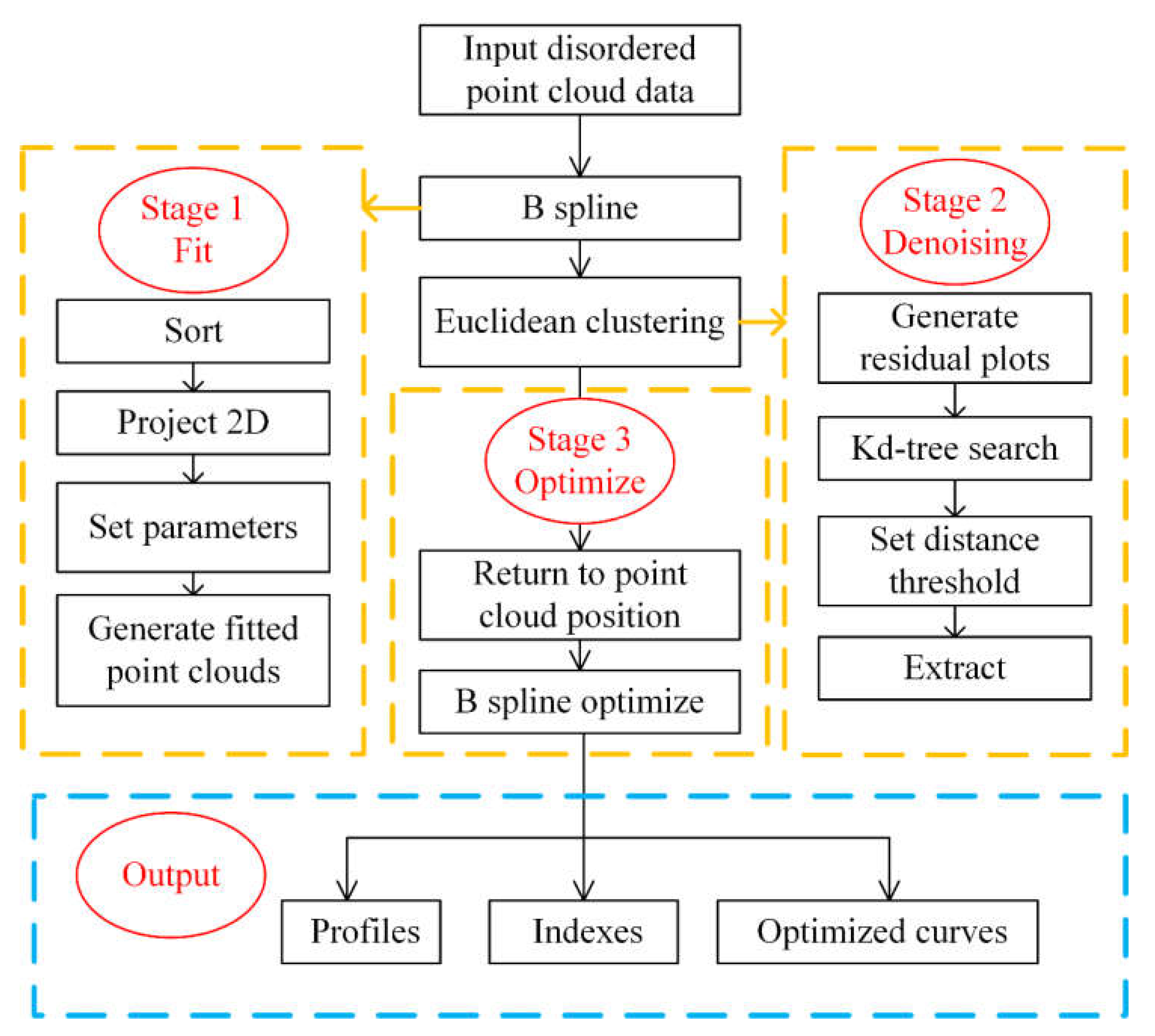
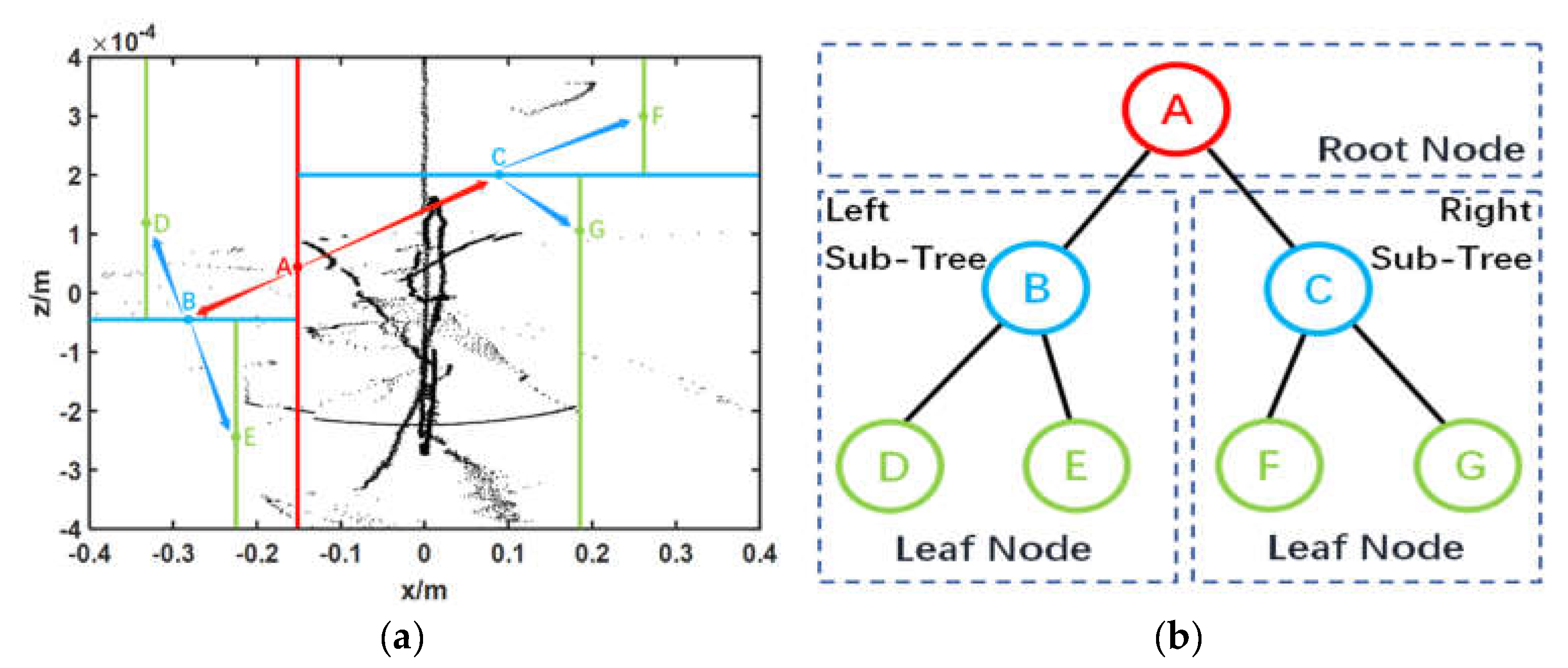
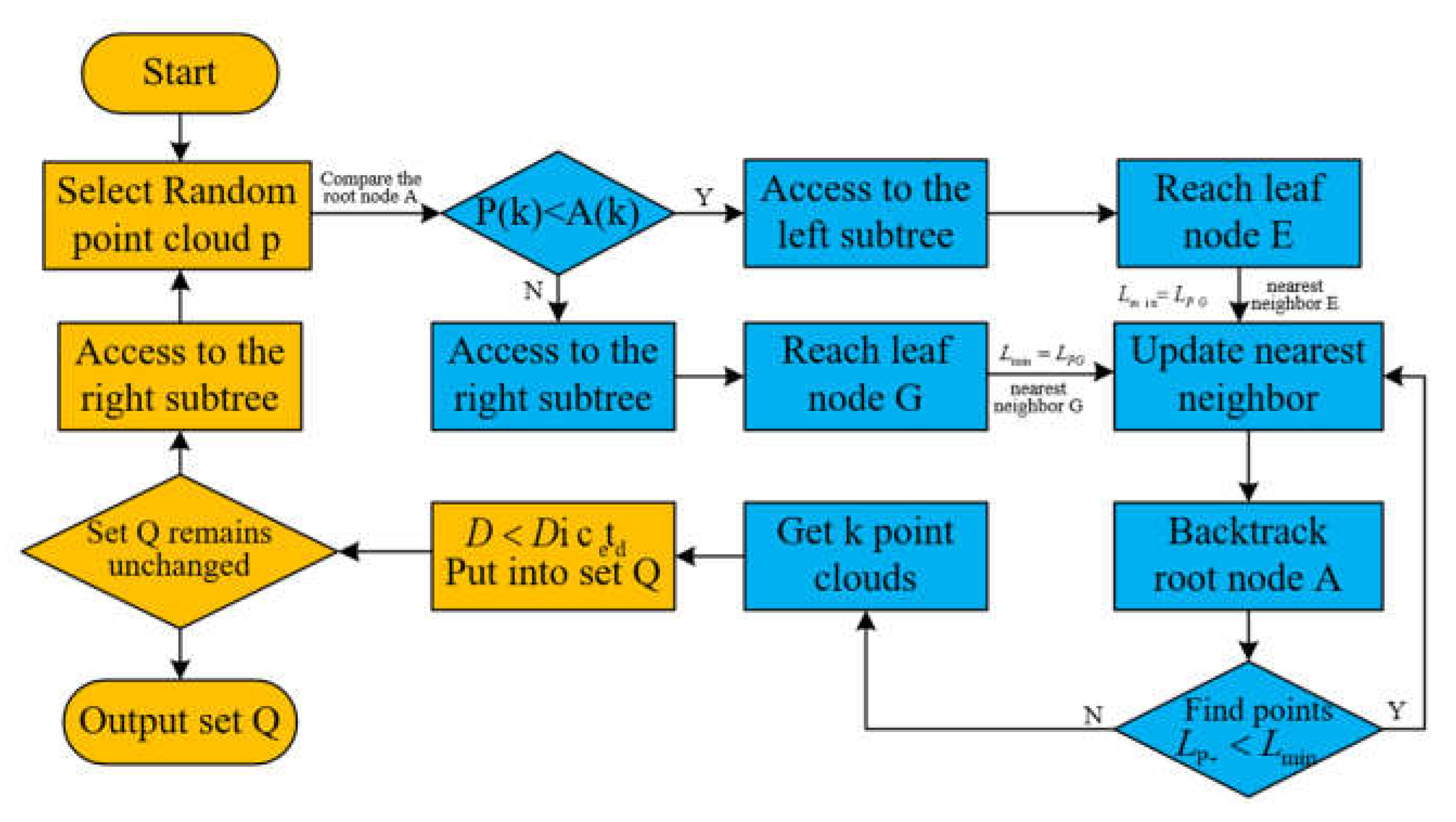








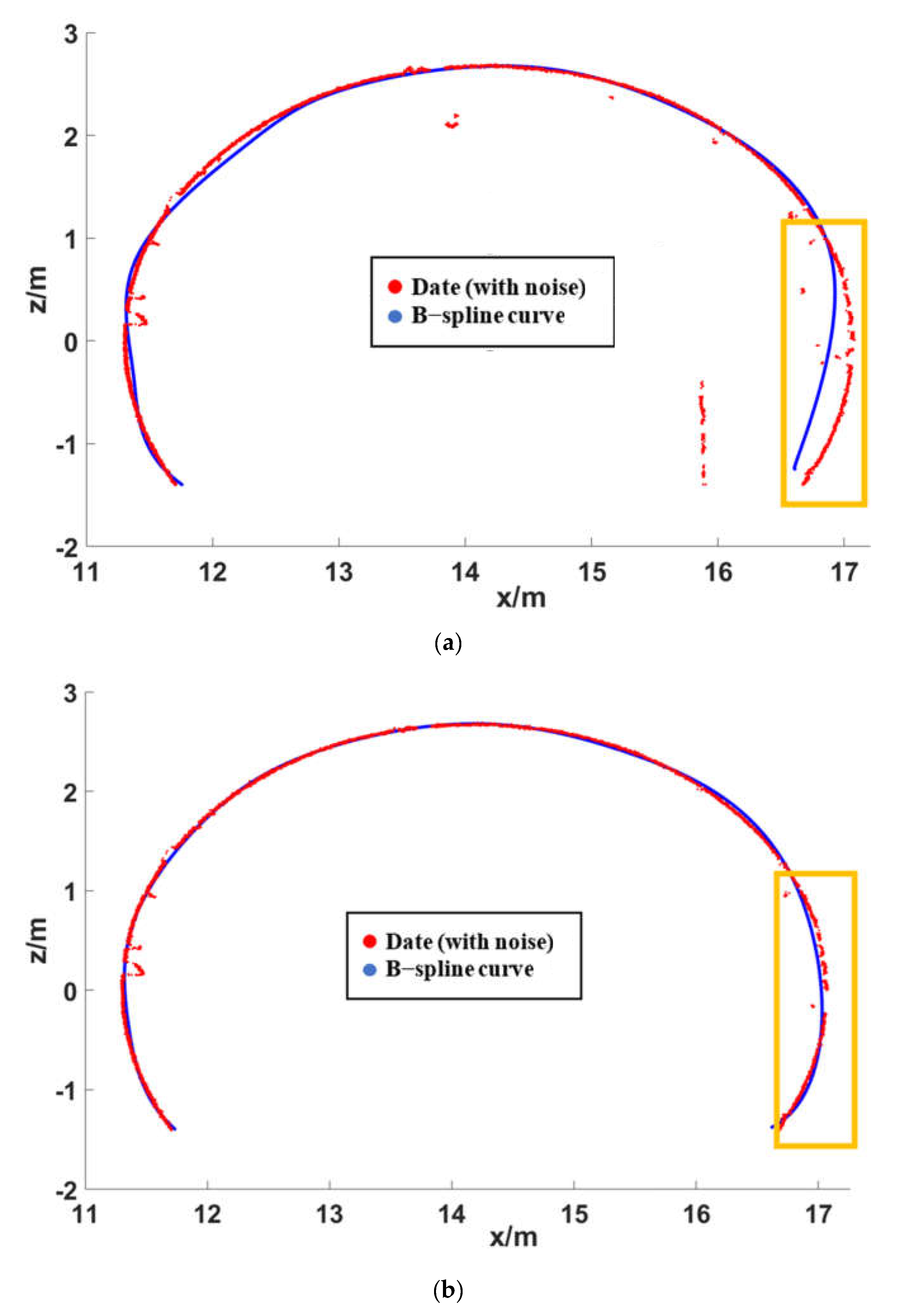
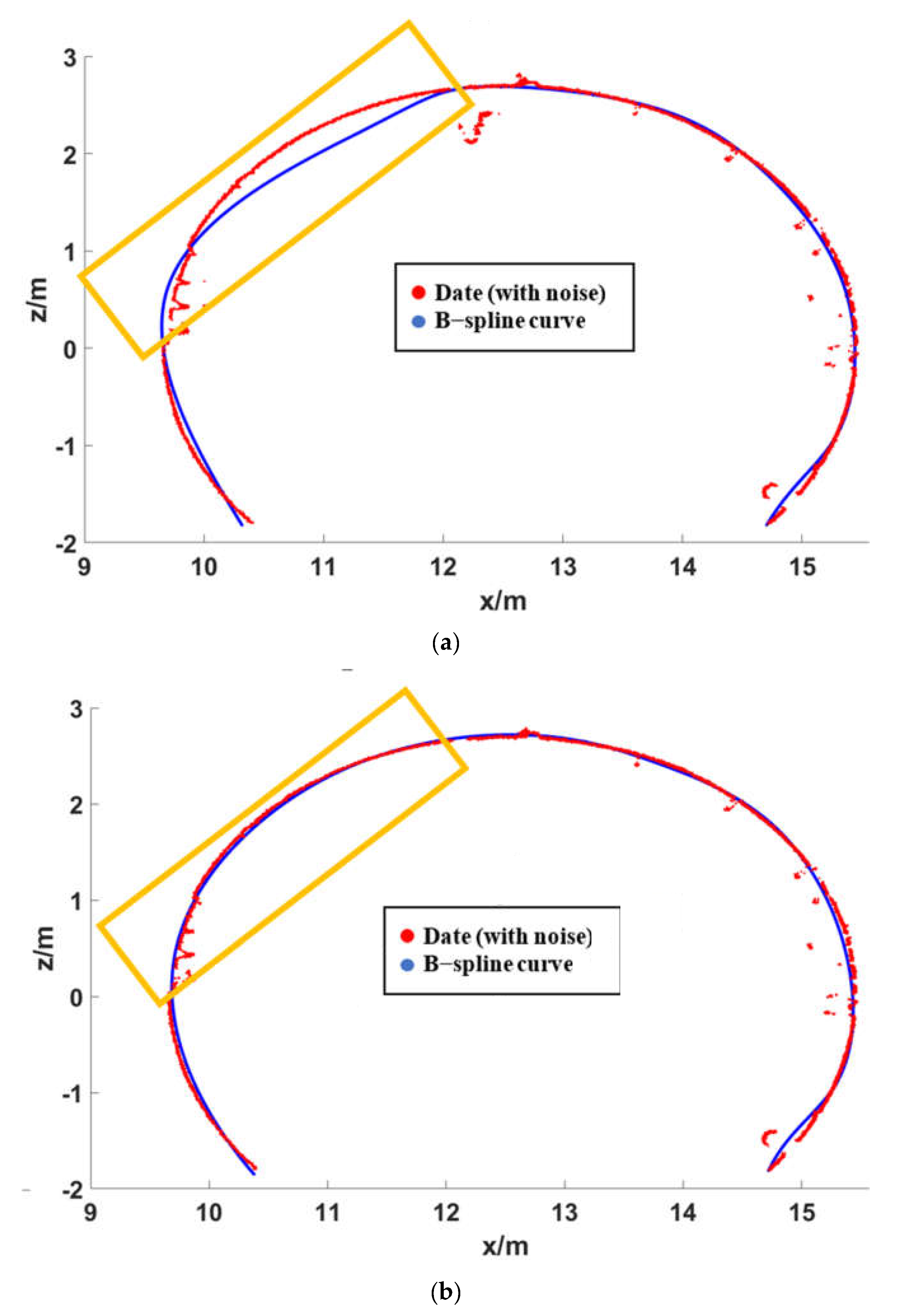
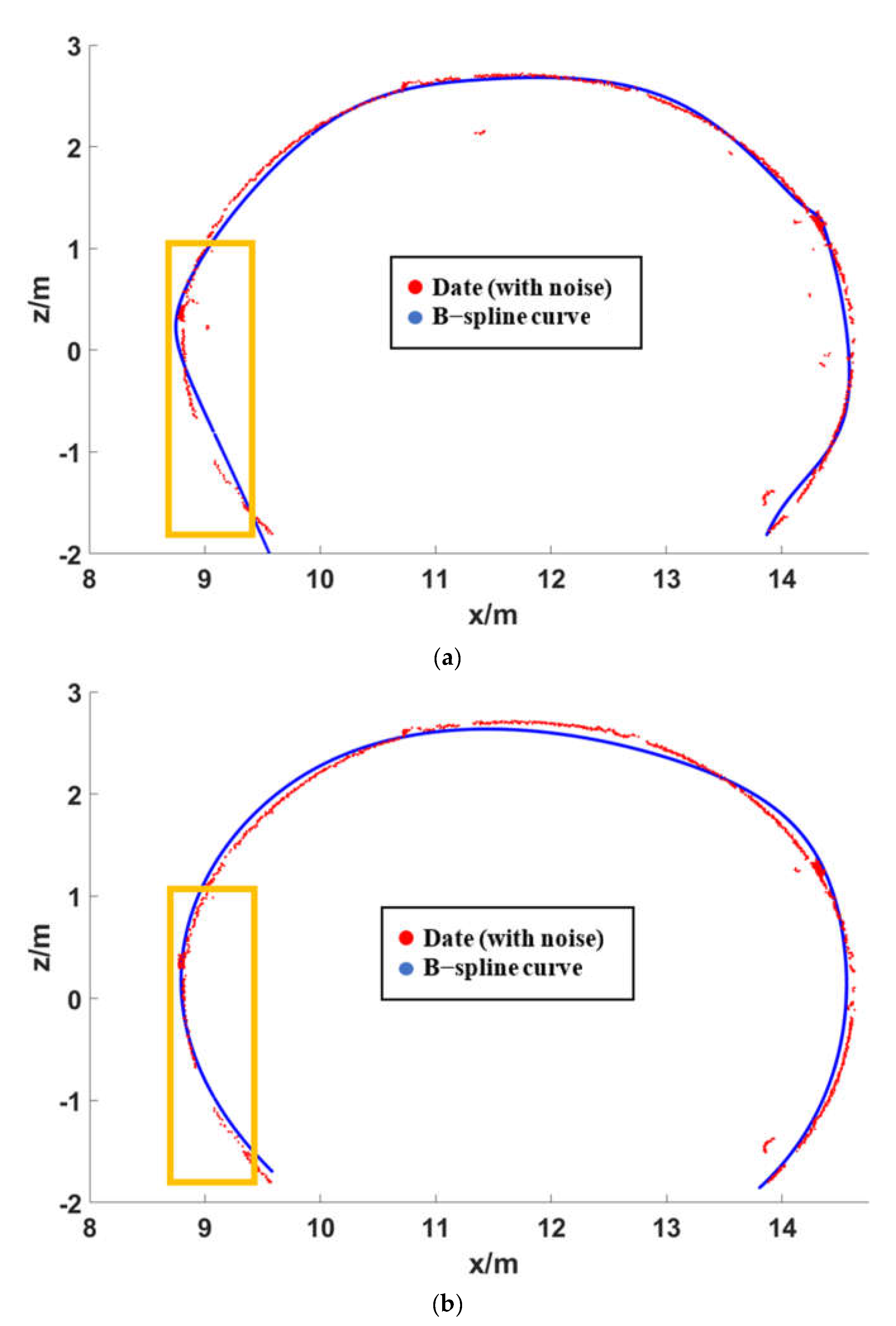

| Confusion Matrix | Predicted Value | ||
|---|---|---|---|
| Set Q | Non Set Q | ||
| True Value | Healthy Point Cloud | TP | FN |
| Noise | FP | TN | |
| Profile | Raw Point Clouds | Labeled Point Clouds |
|---|---|---|
| 1 | 1017 | 897 |
| 2 | 1096 | 943 |
| 3 | 1080 | 935 |
| 4 | 1180 | 1100 |
| 5 | 1320 | 1232 |
| 6 | 1651 | 1286 |
| 7 | 1956 | 1808 |
| 8 | 2303 | 2134 |
| 9 | 4048 | 2673 |
| 10 | 4067 | 3886 |
| 11 | 6575 | 6078 |
| 12 | 6166 | 5819 |
| 13 | 7520 | 6581 |
| 14 | 7988 | 6832 |
| Profile | Precision | Recall | F1-Score | RI |
|---|---|---|---|---|
| 1 | 0.9533 | 0.9777 | 0.9653 | 0.9381 |
| 2 | 0.9098 | 0.9735 | 0.9406 | 0.8922 |
| 3 | 0.8866 | 0.9786 | 0.9304 | 0.8731 |
| 4 | 0.9443 | 0.9709 | 0.9574 | 0.9195 |
| 5 | 0.9541 | 0.9959 | 0.9746 | 0.9519 |
| 6 | 0.8182 | 0.9627 | 0.8846 | 0.8044 |
| 7 | 0.9556 | 0.9873 | 0.9712 | 0.9458 |
| 8 | 0.9421 | 0.9986 | 0.9695 | 0.9418 |
| 9 | 0.6858 | 0.9334 | 0.7907 | 0.6737 |
| 10 | 0.9885 | 0.9977 | 0.9931 | 0.9867 |
| 11 | 0.9410 | 0.9913 | 0.9655 | 0.9344 |
| 12 | 0.9787 | 0.9938 | 0.9862 | 0.9737 |
| 13 | 0.8874 | 1.0000 | 0.9406 | 0.8890 |
| 14 | 0.8928 | 1.0000 | 0.9434 | 0.8973 |
| Average | 0.9271 | 0.9867 | 0.9555 | 0.9190 |
Publisher’s Note: MDPI stays neutral with regard to jurisdictional claims in published maps and institutional affiliations. |
© 2022 by the authors. Licensee MDPI, Basel, Switzerland. This article is an open access article distributed under the terms and conditions of the Creative Commons Attribution (CC BY) license (https://creativecommons.org/licenses/by/4.0/).
Share and Cite
Wang, Z.; Shi, P.; Xu, X.; Xu, X.; Xie, F.; Yang, H. Automatic Identification and Intelligent Optimization of Tunnel-Free Curve Reconfiguration. Symmetry 2022, 14, 2505. https://doi.org/10.3390/sym14122505
Wang Z, Shi P, Xu X, Xu X, Xie F, Yang H. Automatic Identification and Intelligent Optimization of Tunnel-Free Curve Reconfiguration. Symmetry. 2022; 14(12):2505. https://doi.org/10.3390/sym14122505
Chicago/Turabian StyleWang, Zihan, Peixin Shi, Xunqian Xu, Xiangyang Xu, Feng Xie, and Hao Yang. 2022. "Automatic Identification and Intelligent Optimization of Tunnel-Free Curve Reconfiguration" Symmetry 14, no. 12: 2505. https://doi.org/10.3390/sym14122505
APA StyleWang, Z., Shi, P., Xu, X., Xu, X., Xie, F., & Yang, H. (2022). Automatic Identification and Intelligent Optimization of Tunnel-Free Curve Reconfiguration. Symmetry, 14(12), 2505. https://doi.org/10.3390/sym14122505







